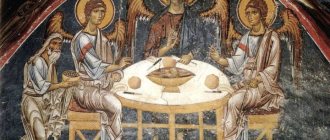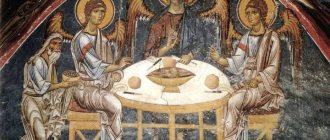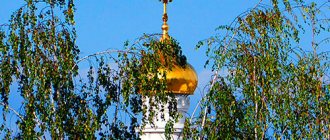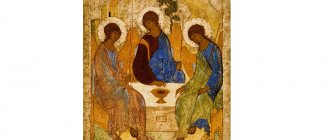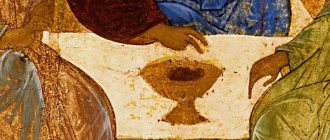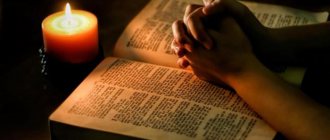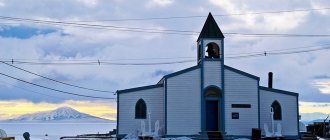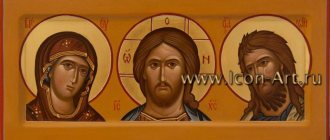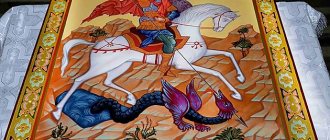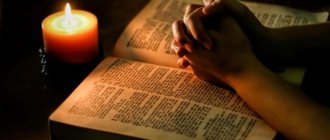The famous icon of St. Andrei Rublev was painted, as is known, in praise of St. Sergius. The insistent advice of the abbot of Radonezh is also known: to look more often at the image of the Holy Trinity, for “by looking at this image the hated discord of this age is overcome.” But in order to overcome this discord, it must first be seen. And see not outside, but inside yourself. Only then can it be overcome by individual “gazing” at the holy image. What can the icon of St. Andrew tell us? Why did Saint Sergius attach such importance to it? Let’s try to take a closer look at this image and at least partially answer these questions.
The “Life-Giving Trinity” icon is based on the biblical text about how three Angels come to the forefather Abraham in the form of three Wanderers. And we accordingly see in the hand of each Angel a wandering staff. However, an icon is never just an illustration of Holy Scripture or Holy Tradition, but, first of all, is always called upon to reveal the revelation of their spiritual meaning. So here, on the one hand, yes, staves, of course, remind of the realities of a historical event, but let us remember that the bishop has a staff or rod. His rod is a symbol of spiritual power. On the Rublev icon, extremely symbolic and therefore laconic in the details of this event, the emphasis is on this meaning. The book of Genesis tells us that when the Strangers approached Abraham's tent, he ran out to meet them and, bowing, invited them into his house, seated them for a meal, and ordered his servant to slaughter a calf for the Guests.
All this happened in the Mamre oak grove. Not far from Mount Moriah. Accordingly, in the upper part of the icon we see what the writer of everyday life tells us about. On the left is the tent of Abraham, painted in the shape of a house, in the center is a tree, also reminiscent of the place where everything happened, and on the right is a mountain. But all these subjects are extremely generalized. The herdsman's tent has been transformed into a raised house with columns and capitals; the tree only reminds of an oak grove, but it is impossible to determine from it that it belongs to any specific species. It’s like “all-in.” And Mount Moriah, although it was not very far from this place, is given in a very general way.
Andrey Rublev Trinity
Holy Scripture speaks of the visit of the Stranger Angels as a manifestation of God to Abraham. With his bodily eyes Abraham saw three Strangers, and with his mind he prophetically saw the one God in them. The icon offers us a picture that can only be seen with spiritual eyes, showing how Eternity was manifested in a temporary event. And precisely because all objects are located clearly above the Angels who represent the Divine, their meanings are transformed. The herdsman’s tent becomes an image of the construction of the world or the “Economy of God,” the oak tree becomes the Tree of Life, and the mountain calls for “the wisdom of the mountains.” At the same time, the mountain, the tree, and even the house are, as it were, bowing to the image of the three Angels.
The central place of the icon is occupied by Angels and the Chalice at the table. The similarity immediately catches the eye - a certain angelic image common to all three: faces, clothes, wings, wands... But despite all the similarities, each Angel is very individual - in a special position, movement of the head, hands, color of clothing. The Middle Angel is dressed in a red chiton (lower garment) and a blue himation (outer garment). There is a stripe on the chiton on the left. This is a clav, a sign of royal dignity. The angel on the left hand of the middle one (to our right) has a blue tunic and a green himation. Finally, on the left, the Angel has a blue chiton and a light purple himation.
Since ancient times, the Church has seen in the visit of the forefather Abraham by three Angels a prototype of the Holy Trinity. At the same time, the colors of clothes, the facing of the Angels to each other, the positions of the hands can even give us the opportunity and desire to specify the “faces” of the Holy Trinity. Thus, the colors of the clothes (in iconography there is a certain symbolism of color) of the middle Angel and the presence of the clave refer us to the stable tradition of depicting the Savior on icons. Jesus Christ is a perfect God and a perfect Man. Accordingly, blue is the color of the sky, red is the color of the earth. He is the King (remember - clave), but, according to His word, His Kingdom is not of this world (John 18:36). Spring and summer greenery speaks of birth, renewal and fulfillment of life. The color of the himation of the right Angel can also remind us of this, but it is like an eternal, unfading green. On the chiton there is also a clave, it is just not as bright as on the average Angel. The lilac color of the left Angel, like the clave of the middle and right, testifies to royalty. The blue of heaven is present in everyone’s clothes. By bowing their heads, the images of the middle and right Angels are facing the Angel written on the left. According to this, it would seem that one can define the left Angel as the Holy Spirit, and the right one as God the Father. But it is important to remember that historically this is not a manifestation of God Himself, but of His Angels.
Mikhail Nesterov Old Testament Trinity
Let me remind you that the Church sees in the appearance to Abraham only a prototype of the Holy Trinity. Even if it is convenient to identify angelic images by certain external signs, it will still be a pure convention, speaking only about Whom the angels represent. For
“No one has ever seen God; The only begotten Son, who is in the bosom of the Father, he has revealed” (John 1:18).
Only the Son of God became Man, therefore only He will be depicted on icons. Neither God the Father nor God the Holy Spirit can be depicted, since God is the Absolute Spirit. It is much more important not to identify them based on visible differences, but to see in the icon “overcoming discord.”
If we mentally place a compass in the middle of the icon and try to describe a circle, then the figures of angels will easily fit into it. The circle is an unusual figure for Christianity. He is a symbol of unity and harmony. But perfect unity and agreement can only be demonstrated by perfect love. And on the icon there is an object that reveals it strongly and unconditionally. This is the Chalice, over which the blessing right hand of the middle Angel seems to hover. Let us remember that it contains a slaughtered calf. And here it is necessary to make a reservation. The image of the Holy Trinity, of course, was painted before the holy icon painter Andrew. But usually there were two more figures on the icon: Abraham and Sarah, as if serving at the table. As a rule, they were painted in the foreground of the icon, just below the meal. Sometimes, in order to show the otherworldliness of the Guests and the abyss separating God and fallen man, Abraham and Sarah were depicted as emphatically much lower than the Angels (as in the fresco of Theophanes the Greek). Another trend is also known. They were depicted standing not in front of the meal, but behind the seated Angels. And this was an attempt by icon painters to bring man closer to God.
What does Reverend Andrew do? He removes Abraham and Sarah altogether. Thus, historical realities become indicated only by objects at the top of the icon. And the image as a whole immediately becomes prophetic and leads the mind’s eye endlessly back into the past, revealing the Eternal Council, where the three Angels are in a secret, silent conversation about the fall of man and the Sacrifice of the Son. And one and a half thousand years ahead from the time of the biblical event, when the Sacrifice has already been completed. And then the slaughtered calf of Abraham becomes only a prototype of the Eucharistic sacrifice of the “slain Lamb who takes away the sins of the world.” But in the way the image of the Holy Trinity was painted by the reverend icon painter, the staff of the Andrei Rublev Museum noticed an extremely important nuance that directly connects the image with the words of St. Sergius. By completely removing people from the icon, St. Andrew gave man the opportunity to become a participant in this mysterious divine communion. After all, having approached the icon, the place of the forefather is quite naturally taken by anyone standing in front of it... Three Angels are sitting at the meal, the fourth side is empty - it is open to man. This is the unconditional approach of a person to God. Moreover, the Cup on the icon is moved as far as possible towards the empty (our) side. As if not insisting, not forcing, but only offering as an opportunity to accept it and thereby enter this mysterious and ineffable area of God's unity, love and harmony. Archpriest Alexander Lavrin
Images of the Holy Trinity in the material world
How can the Lord God be simultaneously One and Trinity? We must not forget that the earthly measurements familiar to us, including the category of number, are not applicable to God. After all, only objects separated by space, time and forces can be counted. And between the Persons of the Holy Trinity there is no gap, nothing inserted, no section or division. The Divine Trinity is absolute unity. The mystery of the Trinity of God is inaccessible to the human mind (see more details). Some visible examples, rough analogies of Her can be:
- the sun is its circle, light and warmth;
- the mind that gives birth to the ineffable word (thought), expressed by breathing;
- a source of water, a spring and a stream hidden in the earth;
- the mind, word and spirit inherent in the godlike human soul.
Simple analogies
Christian missionaries have always found some analogies that help them get closer to the great revealed mystery of the Trinity.
Sun
Speaking about unity in trinity, they point to the sun, which has the shape of a ball, gives birth to light, and exudes heat. Indeed, the sun is perceived by man in three ways: as a ball, as a source of light, as a source of heat, and one - as a star.
Human
The second analogy is the tripartite nature of man. In the trichotomy of man, some theologians see the image and likeness of God. Man, united by nature, has a bodily component, a sensory component and a spiritual component.
Clay brick
Saint Spyridon of Trimifunt testified before the participants of the First Ecumenical Council of the Trinity of the Divinity, clutching a clay brick in his hand. When fire broke out from the brick, water flowed out and sand poured out, the Saint pointed out the three-component nature of the brick and its unity at the same time.
clover shamrock
Saint Patrick, speaking of the Holy Trinity, showed a clover shamrock. The three-component structure of a leaf on one stem helped to understand the principle of the unity of the three.
One nature and three identities
Being one in nature, the Persons of the Holy Trinity differ only in their personal properties: unbornness with the Father, birth with the Son, procession with the Holy Spirit. The Father is beginningless, not created, not created, not begotten; The Son is pre-eternally (timelessly) born of the Father; The Holy Spirit eternally comes from the Father.
The personal properties of the Son and the Holy Spirit are indicated in the Creed: “begotten of the Father before all ages,” “proceeding from the Father.” “Birth” and “procession” cannot be thought of either as a one-time act or as some process extended in time, since the Divine exists outside of time. The very terms: “birth”, “procession”, which the Holy Scripture reveals to us, are only an indication of the mysterious communication of Divine Persons, these are only imperfect images of their ineffable communication. As St. says John of Damascus, “the image of birth and the image of procession is incomprehensible to us.”
There are three Persons in God, three Selves. But the analogy of human faces is not applicable here. The faces are connected not by merging, but by penetrating each other in such a way that they do not exist one outside the other. The Persons of the Most Holy Trinity are in constant mutual communion with each other: the Father abides in the Son and the Holy Spirit; Son in the Father and the Holy Spirit; The Holy Spirit is in the Father and the Son (John 14:10).
Three Persons have:
- one will (desire and will),
- one force
- one action: any action of God is one: from the Father through the Son in the Holy Spirit. The unity of action in relation to God should be understood not as a certain sum of three mutually solidary actions of Persons, but as a literal, strict unity. This action is always just, merciful, holy...
Answer to the question
Photo: Monastir58.ru
The Holy Trinity is a term meaning that God is one in 3 incarnations, persons. God is undivided, but threefold. The word “Trinity” itself, of non-biblical origin, was introduced into the Christian lexicon in the second half of the 2nd century by St. Theophilus of Antioch. The doctrine of the Holy Trinity is given in Christian Revelation. The dogma itself is incomprehensible if you look at it from the point of view of ordinary everyday logic. This treatise is considered the most mysterious, open only to a select few. No wonder Fr. Pavel Florensky called it “the cross of human thought.”
Just as the sun emits light, heat and invisible radiation at the same time, so the Lord has 3 hypostases that are simply impossible to know. The Feast of the Holy Trinity is celebrated on the 50th day of Easter, which falls at a different time every year. On this day, the Day of the Holy Spirit is also celebrated, when greenery is brought to churches, which then sanctifies the house.
The Father is the source of the existence of the Son and the Holy Spirit
The Father (being beginningless) is the only beginning, the source in the Holy Trinity: He eternally gives birth to the Son and eternally gives birth to the Holy Spirit. The Son and the Holy Spirit simultaneously ascend to the Father as one cause, while the origin of the Son and the Spirit does not depend on the will of the Father. The Word and the Spirit, in the figurative expression of Saint Irenaeus of Lyons, are the “two hands” of the Father. God is one not only because His nature is one, but also because those Persons who are from Him ascend to a single person.
The Father has no greater power or honor than the Son and the Holy Spirit.
God the Father
The creator of people, the universe, the beginning began. He is not born, not created, eternal. The Holy Spirit and Jesus Christ (God the Son) are its continuation, incarnation. It is almost impossible to understand and feel this. God the Father knows everything in advance, even the fate of an individual person. Only He knows on what day earthly humanity will end and man will be able to move into the Kingdom of Heaven. Therefore, those who try to predict the end of the world put themselves above God the Father. However, God the Father knows almost everything around everyone. He is the beginning and the end, the highest that exists above us all.
True knowledge of God the Trinity is impossible without the internal transformation of man
Experienced knowledge of the Trinity of God is possible only in mystical revelation through the action of Divine grace, to a person whose heart is cleansed of passions. The Holy Fathers experienced the contemplation of the One Trinity, among them we can especially highlight the Great Cappadocians (Basily the Great, Gregory the Theologian, Gregory of Nyssa), St. Gregory Palamu, St. Simeon the New Theologian, St. Seraphim of Sarov, St. Alexander Svirsky, St. Silouan of Athos.
Saint Gregory the Theologian: “I have not yet begun to think about the Unity, when the Trinity illuminates me with Its radiance. As soon as I began to think about the Trinity, the One took hold of me again.”
How to understand the words “God is Love”
According to the definition given by the Apostle and Evangelist John the Theologian, God is love. But God is love not because He loves the world and humanity, that is, His creation - then God would not be completely Himself outside and apart from the act of creation, would not have perfect being in Himself, and the act of creation would not be free, but forced by the very “nature” of God. According to the Christian understanding, God is love in Himself, because the existence of the One God is the co-existence of the Divine Hypostases, existing among themselves in the “eternal movement of love,” according to the words of the 7th century theologian St. Maximus the Confessor.
Each of the Persons of the Trinity does not live for Himself, but gives Himself without reserve to the other Persons, while remaining completely open to their response, so that all three coexist in love with each other. The life of Divine Persons is interpenetration, so that the life of one becomes the life of another. Thus, the existence of the God of the Trinity is realized as love, in which the individual’s own existence is identified with self-giving.
The doctrine of the Holy Trinity is the basis of Christianity
According to St. Gregory the Theologian, the dogma of the Holy Trinity is the most important of all Christian dogmas. St. Athanasius of Alexandria defines the Christian faith itself as faith “in the unchangeable, perfect and blessed Trinity.”
All the dogmas of Christianity rest on the doctrine of God, one in essence and trinity in Persons, the Trinity Consubstantial and Indivisible. The doctrine of the Most Holy Trinity is the highest goal of theology, since to know the mystery of the Most Holy Trinity in its fullness means to enter into Divine life.
To explain the mystery of the Holy Trinity, the holy fathers pointed to the human soul, which is the Image of God. “Our mind is the image of the Father; our word (we usually call the unspoken word a thought) is the image of the Son; spirit is the image of the Holy Spirit,” teaches Saint Ignatius Brianchaninov. – Just as in the Trinity-God the three Persons unfused and inseparably constitute one Divine Being, so in the Trinity-Man the three Persons constitute one being, without mixing with each other, without merging into one person, without dividing into three beings. Our mind has given birth to and does not cease to give birth to a thought; a thought, having been born, does not cease to be born again and at the same time remains born, hidden in the mind. The mind cannot exist without thought, and thought cannot exist without the mind. The beginning of one is certainly the beginning of the other; the existence of the mind is necessarily the existence of thought. In the same way, our spirit comes from the mind and contributes to thought. That is why every thought has its own spirit, every way of thinking has its own separate spirit, every book has its own spirit. Thought cannot exist without spirit; the existence of one is certainly accompanied by the existence of the other. In the existence of both is the existence of the mind.”
The very doctrine of the Holy Trinity is the doctrine of “Mind, Word and Spirit - one co-nature and divinity,” as St. Gregory the Theologian. “The First Existing Mind, God, who is consubstantial in Himself, has the Word with the Spirit co-essential, never being without the Word and the Spirit,” teaches St. Nikita Studiysky.
The Christian doctrine of the Holy Trinity is the doctrine of the Divine Mind (Father), the Divine Word (Son) and the Divine Spirit (Holy Spirit) - Three Divine Persons possessing a single and inseparable Divine Being.
God has an all-perfect Mind (Reason). The Divine Mind is beginningless and infinite, limitless and unlimited, omniscient, knows the past, present and future, knows the non-existent as already existing, knows all creations before their existence. In the Divine Mind there are ideas of the entire universe, there are plans for all created beings. “Everything from God has its being and existence, and everything before being is in His creative Mind,” says St. Simeon the New Theologian.
The Divine Mind eternally gives birth to the Divine Word, with which He creates the world. The Divine Word is “the Word of the Great Mind, surpassing every word, so that there was not, is not, and will not be a word that is higher than this Word,” teaches St. St. Maximus the Confessor. The Divine Word is All-perfect, immaterial, soundless, does not require human language and symbols, beginningless and endless, eternal. It is always inherent in the Divine Mind, born from Him from eternity, which is why the Mind is called the Father, and the Word the Only Begotten Son.
The Divine Mind and the Divine Word are spiritual, because God is immaterial, incorporeal, immaterial. He is the All-Perfect Spirit. The Divine Spirit resides outside of space and time, has no image or form, and is above any limitation. His All-Perfect Being is limitless, “incorporeal, and without form, and invisible, and indescribable” (St. John of Damascus).
The Divine Mind, Word and Spirit are entirely Personal, which is why They are called Persons (Hypostases). Hypostasis or Person is the personal way of being of the Divine essence, which equally belongs to the Father, the Son and the Holy Spirit. The Father, Son and Holy Spirit are one in Their Divine nature or essence, consummate in nature and consubstantial. The Father is God, and the Son is God, and the Holy Spirit is God. They are completely equal in Their Divine dignity.
Each Person has omnipotence, omnipresence, perfect holiness, the highest freedom, uncreated and independent of anything created, uncreated, eternal. Each Person carries within Himself all the properties of the Divine. The doctrine of three Persons in God means that the relationship of the Divine Persons for each Person is threefold. It is impossible to imagine one of the Divine Persons without the existence of two Others at once.
The Father is Father only in relation to the Son and the Spirit. As for the birth of the Son and the procession of the Spirit, one presupposes the other. God is “Mind, the Abyss of Reason, the Parent of the Word and through the Word the Maker of the Spirit Who reveals Him,” teaches St. John of Damascus.
The Father, the Son and the Holy Spirit are three full-fledged Persons, each of Whom has not only the fullness of being, but is also fully God. One Hypostasis is not a third of the total essence, but contains within itself the entire fullness of the Divine essence. The Father is God, and not a third of God, the Son is also God and the Holy Spirit is also God. But all Three together are not three Gods, but one God. We confess “the Father and the Son and the Holy Spirit - the Trinity, consubstantial and indivisible” (from the Liturgy of St. John Chrysostom). That is, the three Hypostases do not divide a single essence into three essences, but the single essence does not merge or mix three Hypostases into one.
Slavs
- one of the most important holidays of the Orthodox church calendar, celebrated on the 50th day after Easter (hence its second name - Pentecost). In folk tradition, T. is included in the complex of several holidays. For the Russians, it began with Semik, that is, Thursday of the seventh week after Easter; The next notable date of this cycle is the Saturday on the eve of T., celebrated among the Eastern Slavs as one of the main memorial dates of the year (cf. the names of this day: “parental Saturday”, “suffocating” or “spiritual Saturday”, “Trinity grandfathers”). Following Trinity Sunday, a week began, called by the Eastern Slavs “Trinity”, “Rusal”, “Wired”, etc., and by the Catholic Slavs “Green Christmastide” or “Green Week”. In its composition, two main dates stood out: Spiritual Day and Thursday, called in the southern Russian regions and in the Polesie zone “Trinity of the Dead”, “Navskaya Trinity”, “Rusalchin Great Day”. In popular beliefs, this period of the calendar was perceived as harmful and dangerous (cf. its Polesie names: “harmful” or “crooked” week); people born at this time were predicted to have an unhappy fate, and those who died were predicted to become “unclean” spirits. Judging by some folklore texts and beliefs, the “Holy Trinity” was represented as a single female character. Dedicated to these days, the folk custom of decorating houses, outbuildings, churches, courtyards and village streets with fresh greenery is common to all Slavs (both Orthodox and Catholic). On the eve of Pentecost, “Trinity greens” were prepared: people brought whole carts of cut branches and young trees, herbs and flowers. Ritual wreaths were woven from them; this greenery was used to cover the floors of houses and churches; branches were stuck into windows and doors of houses, into gates and fences, and hung over wells; the trees were buried in the yard near the house, under the windows, in the corners of the house, along rural streets, etc. After three days, all the “Trinity” greenery was taken outside the living space and destroyed in ritual ways: floated on water, burned in ritual bonfires, thrown onto trees or roofs of houses. The remains of dried herbs and branches were preserved as a remedy or a talisman against evil spirits, natural disasters, rodents and insects. The customs of the Semitic-Trinity cycle among the Russians were especially widespread and ubiquitous, among them the well-known rituals with the “Trinity” birch tree stood out. In Semik, girls went into the forest to “curl” birch trees: they twisted the branches into rings, fastening them with ribbons (see Birch). At the same time, a rite of communion was performed, that is, girls kissed in pairs through such birch circles and exchanged their crosses or other things while singing special songs (“Let’s kiss, godfather, let’s kiss, so that we don’t fight with you...”), after which they called each other friend's godfather. On Trinity Day, they came to this place again, untied the birch branches and “spent money”, returning their things. An important element of the Trinity cycle are funeral rites, most pronounced among the Eastern and Southern Slavs. In the Russian North, T. and the previous Saturday were considered the main memorial dates of the year. In church sources of the 16th-18th centuries. the folk custom was condemned when “on Trinity Saturday, husbands and wives gather around the village and churchyard in mourning and mourn over the graves of the dead with a great cry.” The Saturday before T. was considered one of the main memorial dates among the southern Slavs (see Zadushnitsy). In the southern Russian regions and Polesie, Friday and Saturday before T. were celebrated as days when it was possible to remember the “unclean” dead. In the Chernihiv region they said that these were the main memorial “grandfathers” of the year, when it was imperative to remember all the drowned and hanged people from their family. The customs of commemorating those who died a violent or premature death correlate with beliefs about the appearance on earth at this time of the souls of dead children or girls who did not live to get married, that is, mawoks and mermaids. Parents who experienced the death of unmarried daughters or young children performed funeral rituals especially carefully: they left food intended for souls on the table overnight; they hung clothes for mermaids on the fence; they observed the prohibitions of sewing, spinning, whitewashing the walls of the house and stove, and working in the fields, so as not to harm the invisibly present mermaids. To remember their children who died in infancy, mothers took them to the cemetery and distributed colored eggs and pies to fellow villagers. In the northern regions of Bulgaria, T. and Rusal Week were revered as “a holiday of mermaids and samodivas,” so women refrained from all types of work outside the home, so that the mermaids would not punish them with an incurable disease. This same period was considered the only time in the year when it was possible to cure patients with the “Rusal” or “Samodiv” disease: for this purpose, special ritual persons walked around the village - male squads who performed magical round dances around the patient (see Rusalia). According to widespread beliefs among the Eastern and Southern Slavs, in the last days of the Trinity cycle, the souls of the dead return to the afterlife, therefore, the rituals of this period reflect numerous motives for “farewell” to them and “seeing off”, that is, ushering the dead out of earthly space. For example, the Bulgarian and Macedonian custom of covering the floor of the church with walnut leaves on Spiritual Day was done in order to say goodbye to souls and help the dead cross back to the “other world.” Among the Eastern Slavs, the final stage of the Trinity cycle is characterized by various forms of ritual “seeing off”: for example, the destruction of Trinity greenery; “expelling the mermaid”, “driving the bush” (or “spring”, “poplar”, “duck”); “farewell” to the pair of mummers “Semik and Semichikha”; “funeral of the cuckoo”, etc. Lit.: Sokolova V.K. Spring-summer calendar rituals of Russians, Ukrainians and Belarusians. M., 1979. S. 188-227. L. N. Vinogradova < SMES
Can a Christian address each of the three Persons of the Holy Trinity?
Undoubtedly: in the prayer “Our Father” we turn to the Father, in the Jesus prayer to the Son, in the prayer “Heavenly King, Comforter” - to the Holy Spirit. Who does each of the Divine Persons recognize Himself as and how can we correctly recognize our conversion so as not to fall into the pagan confession of three gods? Divine Persons do not realize themselves as separate Personalities.
- We turn to the Father, who eternally gives birth to the Son, whose spokesman is the Holy Spirit, who eternally emanates from the Father.
- We turn to the Son, eternally begotten of the Father, whose spokesman is the Holy Spirit eternally proceeding from the Father.
- We turn to the Holy Spirit as the exponent of the Son, who is eternally born of the Father.
Thus, our prayers do not contradict the teaching about the unity (including will and action) and inseparability of the Persons of the Holy Trinity.
Important links
| Divine Qualities | Father | Son | Holy Spirit |
| Eternal | Rom.14:25 | Rev.1:17 | Heb.9:14 |
| Creator of everything | Ps.99:3 | Col. 1:16 | Isa.40:13 |
| Omnipresent (can be everywhere at once) | Jer.23:24 | Matthew 28:20 | Ps.139:7 |
| Omniscient (knows everything) | Matthew 11:27 | John 21:17; see also Matthew 11:27 | 1 Corinthians 2:10 |
| Has a will and performs supernatural actions | Eph.1:5 | Matthew 8:3 | 1 Corinthians 12:11 |
| Gives life | Gen.1:11-31; see also John 5:21 | John 1:4; see also John 5:21 | Rom.8:10; see also John 3:8 |
| Strengthens Believers | Ps.137:3 | Phil.4:13 | Eph.3:16 |
Note:
In the Greek text of this verse the Holy Spirit is called the “Eternal Spirit.”
Why you need to know the doctrine of the Holy Trinity
First of all, comprehension of the doctrine of the Most Holy Trinity is necessary in fulfillment of the Divine instruction given through the Apostle; for the sake of unity with God and inheritance of eternal blessed life in the Kingdom of Heaven: “This is eternal life, that they may know You, the only true God, and Jesus Christ whom You have sent” (John 17:3).
An Orthodox Christian every time confesses the truth about the Holy Trinity, making the sign of the cross through the making of the finger.
From a more specific perspective, this knowledge is necessary:
- For a correct, meaningful understanding of the Holy Gospel and the Apostolic Epistles. Without knowing the basics of the doctrine of the Trinity, it is impossible not only to understand the preaching of Christ, but it is also impossible to even understand who this Evangelist and Preacher really is, who Christ is, whose Son He is, who His Father is.
- For a correct understanding of the content of the Books of the Old Testament. Indeed, despite the fact that the Scripture of the Old Testament mainly reports about God as the One Ruler, it nevertheless contains passages that can be exhaustively interpreted only in the light of the teaching about Him as the Trinity in Persons. Such places include, for example: a) the story of God’s appearance to Abraham in the form of three strangers (Gen. 18:1-16); b) the psalmist’s verse: “By the word of the Lord the heavens were established, and by the Spirit of His mouth was all their strength” (Ps. 32:6). In fact, the Holy Books of the Old Testament contain not two or three, but many such passages. (It is worthy of note that the concept “Spirit” does not always designate the third Person of the Holy Trinity. Sometimes this designation means a single Divine action).
- To understand the meaning and significance of the Sacrifice of the Cross. Without knowledge of the teachings about the Father and the Son and the Holy Spirit, it is impossible to understand by whom and to whom this Sacrifice was offered, what is the dignity of this Sacrifice, what is the price of our Redemption). If a Christian's knowledge were limited to the knowledge of God as the One Ruler, he would be faced with an insoluble question: why did God sacrifice Himself?
- Without knowledge of the Divine Trinity, it is impossible to fully understand many other provisions of Christianity; for example, the truth that “God is love” (1 John 4:8). If we, out of ignorance of the doctrine of the Trinity, knew about God only as One, then we would not know to Whom, outside of relation to the world, His infinite Love extends, to Whom it was poured out before the Creation of the world, in eternity. If we believed that God's Love extends only to His creation, in particular to man, it would be easy to slip into the idea that He is the Lover and not the (infinite in Himself) Love. The doctrine of the Trinity tells us that the Trinitarian God has always abided and abides in intra-Trinitarian Love. The Father eternally loves the Son and the Spirit; Son - Father and Spirit; The Spirit is of the Father and the Son. At the same time, Each Divine Hypostasis also loves Itself. Therefore, God is not only the One who pours out Divine Love, but also the One on whom Divine Love is poured out.
- Ignorance of the doctrine of the Trinity serves as a breeding ground for misconceptions. Weak, superficial knowledge of the doctrine of the Father and the Son and the Holy Spirit is also not a guarantee against deviation into heresy. The history of the Church contains a lot of evidence of this.
- Without knowing the teachings about the Holy Trinity, it is impossible to engage in missionary work, in fulfillment of the commandment of Christ: “Go and teach all nations...” (Matthew 28:19).
How to explain the doctrine of the Holy Trinity to a non-Christian?
To better explain the dogma of the Holy Trinity, the holy fathers used a number of publicly available analogies. Within the framework of one of them, God, as the Highest, Supreme Mind, is compared with the human mind (see in detail: Dogma of the Holy Trinity).
It is noteworthy: even pagans and atheists can agree with the statement that there is rationality in the structure of the world. In this regard, this analogy can serve as a good apologetic tool.
The essence of the analogy is as follows. The human mind expresses itself through thought.
Usually human thought is formulated in words. With this in mind, we can say: the human thought-word is born by the mind (from the mind) in the likeness of how the Divine Word (God the Word, the Son of God) is born by the Father, from the Father.
When we want to express our thought (voice it, pronounce it), we use our voice. In this case, the voice can be called the expresser of thought. In this one can see the similarity with the Holy Spirit, Who is the Exponent of the Word of the Father (the Exponent of God the Word, the Son of God).
***
According to legend, when St. Augustine was walking along the seashore, reflecting on the mystery of the Holy Trinity, he saw a boy who dug a hole in the sand and poured water into it, which he scooped up from the sea with a shell. St. Augustine asked why he was doing this. The boy answered him: “I want to scoop the whole sea into this hole!” Augustine grinned and said that this was impossible. To which the boy said to him: “How are you trying to exhaust the inexhaustible mystery of the Lord with your mind?” And then the boy disappeared.
***
“The Triad is truly the Monad, for it exists thus, and the Monad is truly the Triad, for it is thus hypostasized.” St. Maxim the Confessor
